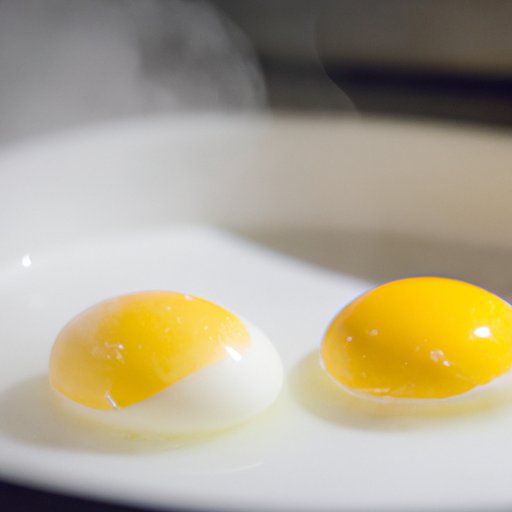Introduction
Do you struggle to make perfect eggs every time you use the microwave? Do you worry about the supposed dangers of microwaving eggs? In this article, we’ll show you how easy it is to microwave eggs with step-by-step instructions, helpful tips, and tasty recipes. We’ll also debunk some myths and explain the science behind microwaving eggs.
A Step-by-Step Guide to Microwaving Eggs
Before microwaving eggs, you need to prepare them properly. Crack the eggs into a bowl and whisk them together with a fork. You can add milk, salt, pepper, or any other seasonings you like at this point.
Next, choose a microwave-safe container and grease it with cooking spray or butter. A small bowl or ramekin works well for a single serving of eggs. Avoid using metal or foil containers in the microwave, as they can cause a fire.
Then, cover the container with a microwave-safe plate to prevent splattering. Set the timer for your desired cooking time and adjust the power level if needed. For example, for two eggs, set the timer for 1 minute and 30 seconds on 50% power.
Once the eggs are cooked, remove them carefully and let them cool for a minute before eating or handling. Note that the cooking time may vary depending on the wattage of your microwave, so experiment to find the right timing for your preference.
Tips and Tricks for Perfect Microwaved Eggs
With microwaved eggs, you can achieve different textures depending on your cooking time and power level. For example, cooking on high power for a longer time produces a harder texture, while cooking on low power for a shorter time results in a softer texture.
You can also add flavor and variety to microwaved eggs with different ingredients. Try adding grated cheese, diced vegetables, or chopped herbs to the egg mixture before microwaving. You can also top the cooked eggs with salsa, guacamole, or hot sauce for a kick of flavor.
If your eggs come out too dry or rubbery, try reducing the cooking time or adding a splash of milk to the egg mixture. If your eggs are still runny, continue microwaving them for a few more seconds until fully cooked.
Healthy Breakfast on the Go – Microwaved Egg Recipes
With microwaved eggs, you can make quick and healthy breakfasts even on busy mornings. Here are some easy recipes to try:
Breakfast Burrito
You’ll need: 2 eggs, 2 tortillas, 1/4 cup shredded cheese, 2 tablespoons salsa, salt and pepper
Instructions: Whisk the eggs in a microwave-safe bowl and season with salt and pepper. Microwave on high for 1 minute and 30 seconds. Meanwhile, warm the tortillas in the microwave for 15 seconds. Layer the cooked eggs, cheese, and salsa on top of the tortillas and roll them up. Enjoy!
Veggie Omelette
You’ll need: 2 eggs, 1/4 cup diced vegetables (such as bell peppers, onions, or spinach), 1/4 cup shredded cheese, salt and pepper
Instructions: Whisk the eggs in a microwave-safe bowl and season with salt and pepper. Stir in the vegetables and cheese. Microwave on high for 1 minute and 30 seconds. Let it cool for a minute before slicing and serving.
How Microwaving Eggs Differs from Other Methods of Cooking Eggs
Microwaving eggs is a convenient and fast way to cook them, but it has some pros and cons compared to other methods. Boiling eggs in water is a classic method that results in a consistent texture, while frying or scrambling eggs gives them a crispy or creamy texture respectively.
However, microwaving eggs is faster than boiling or frying, and it doesn’t require any additional oil or water. Plus, microwaved eggs are less likely to get overcooked or undercooked if you follow the right timing and power level.
Some people worry about the safety of microwaving eggs, as they might explode or overheat. However, as long as you use a microwave-safe container and cover it with a plate while cooking, the eggs should cook evenly and safely.
The Science Behind Microwaving Eggs
Microwaves work by emitting electromagnetic waves that excite the water and fat molecules in food, causing them to heat up and cook. Eggs contain both water and fat, which makes them an ideal food for microwaving.
The egg yolk and white also react differently to the microwave waves, which allows you to achieve different textures and temperatures depending on the cooking time and power level. For example, the yolk heats up faster than the white, which can result in a slightly different texture of the cooked egg.
Interestingly, microwaving an egg in its shell can cause it to explode due to the steam buildup inside the shell. That’s why it’s important to always crack the eggs into a microwave-safe container before cooking.
The Dos and Don’ts of Microwaving Eggs
To recap, here are some important tips to keep in mind when microwaving eggs:
- Always use a microwave-safe container and cover it with a plate or lid while cooking.
- Adjust the power level and cooking time depending on your desired texture and the wattage of your microwave.
- Experiment with seasonings, ingredients, and recipes to add variety and flavor.
- Be cautious when handling the hot eggs and let them cool for a bit before touching them.
- Avoid microwaving eggs in their shells or using metal or foil containers.
Conclusion
Now that you know how easy and delicious it is to microwave eggs, there’s no need to struggle with stove-top methods or skip breakfast on busy days. With the step-by-step guide, helpful tips, and tasty recipes in this article, you can enjoy perfect microwaved eggs every time.
